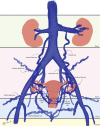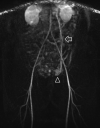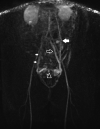Pelvic Venous Disorders: An Update in Terminology, Diagnosis, and Treatment
- PMID: 37575340
- PMCID: PMC10415053
- DOI: 10.1055/s-0043-1771041
Pelvic Venous Disorders: An Update in Terminology, Diagnosis, and Treatment
Abstract
Pelvic venous disorder (PeVD) is a term that encompasses all the interrelated causes of chronic pelvic pain (CPP) and perineal/lower extremity varicose veins of pelvic venous origin historically known as nutcracker syndrome, pelvic congestion syndrome, and May-Thurner syndrome, resulting in a more precise diagnosis that accounts for the underlying pathophysiology and anatomy. PeVD manifests as CPP with associated vulvar and lower-extremity varicosities, left flank pain and hematuria, and lower extremity pain and swelling secondary to obstruction or reflux in the left renal, ovarian, or iliac veins. This article will focus specifically on the most current nomenclature, evaluation, and management of CPP of venous origin.
Keywords: embolization; interventional radiology; pelvic pain; pelvic venous disease; sclerotherapy; women's health.
Thieme. All rights reserved.
Conflict of interest statement
Conflict of Interest None declared.
Figures






References
-
- Chronic pelvic pain: ACOG Practice Bulletin, number 218. Obstet Gynecol. 2020;135(03):e98–e109. - PubMed
-
- Mathias S D, Kuppermann M, Liberman R F, Lipschutz R C, Steege J F. Chronic pelvic pain: prevalence, health-related quality of life, and economic correlates. Obstet Gynecol. 1996;87(03):321–327. - PubMed
-
- Ahangari A. Prevalence of chronic pelvic pain among women: an updated review. Pain Physician. 2014;17(02):E141–E147. - PubMed
-
- Lamvu G, Carrillo J, Ouyang C, Rapkin A. Chronic pelvic pain in women: a review. JAMA. 2021;325(23):2381–2391. - PubMed
-
- Merrill R M. Hysterectomy surveillance in the United States, 1997 through 2005. Med Sci Monit. 2008;14(01):CR24–CR31. - PubMed
Publication types
LinkOut - more resources
Full Text Sources

